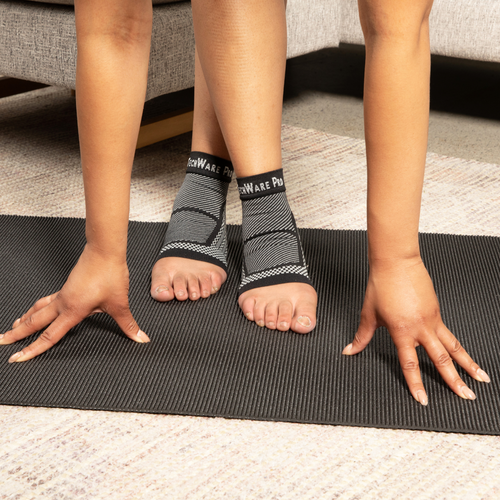
You've twisted your ankle one too many times on the basketball court or gone overboard on the hiking trails. Your doctor recommends wearing an ankle sleeve to provide compression and stability. But before you slip one on, there are some common mistakes to avoid. Wearing an ankle sleeve incorrectly could lead to further injury or discomfort. Let's dive into the dos and don'ts so you can rock that sleeve with confidence!
1.
One of the biggest no-nos when wearing an ankle sleeve is putting it on incorrectly. You might be tempted to just yank it over your foot and ankle, but that's a recipe for bunching and improper fit. Instead, take a moment to roll or fold the sleeve onto itself before gently pulling it up your foot and over your ankle. This ensures a smooth, wrinkle-free application that will move with your ankle rather than constricting it.
2.
Another common pitfall is wearing the wrong size ankle sleeve. You'll want to measure the circumference of your ankle at its slimmest point to get the right fit. An ankle sleeve that's too loose won't provide the compression and support you need, while one that's too tight can cut off circulation. Most brands offer sizing charts to help you pick the perfect one for your ankle measurements.
3.
Don't make the mistake of wearing your ankle sleeve 24/7. While it may be tempting to keep that compression going, your ankle actually needs time to breathe. Aim to wear the sleeve during physical activity or when you'll be on your feet for extended periods. But take it off when resting or sleeping to allow proper blood flow.
4.
Wearing an ankle sleeve doesn't give you a free pass to push your ankle past its limits. You still need to listen to your body's cues and avoid high-impact activities if you're recovering from an injury. The sleeve is meant to provide support during reasonable physical activity, not enable you to go full-throttle before your ankle is ready.
5.
When it comes to material, avoid ankle sleeves made with cheap, non-breathable fabrics. You want something moisture-wicking that will keep your ankle cool and dry during sweaty workouts or warm weather. Look for sleeves made with high-quality neoprene or other technical fabrics designed for athletic wear.
6.
Don't fall into the trap of wearing the same ankle sleeve forever. Over time, the material can break down, losing its elasticity and supportive qualities. Most sleeves should be replaced every 6 months to a year with regular use. Inspect your sleeve regularly for signs of wear and tear like fraying, holes, or loss of compression.
7.
While an ankle sleeve can provide welcomed support, don't use it as a crutch to avoid properly rehabbing an injury. Wear it in conjunction with prescribed physical therapy exercises to strengthen the muscles around your ankle. Relying solely on the sleeve without doing the work can lead to further instability down the road.
8.
If you have a latex allergy, be sure to choose an ankle sleeve made without any latex components. Many are made with latex-free neoprene or other hypoallergenic materials, but it's always wise to double check. Having an allergic reaction while wearing the sleeve could lead to discomfort and irritation, potentially worsening your injury.
9.
Hygiene is key when wearing any type of compression garment against your skin. Make sure to wash your ankle sleeve regularly with mild detergent to keep bacteria and funky smells at bay. You'll also want to let it fully air dry between uses rather than sealing it up in your gym bag while damp. Always follow the washing instructions provided by the seller of the product.
10.
Don't try to be a hero and "push through the pain" while wearing your ankle sleeve. If you experience increasing discomfort, swelling or numbness in your ankle or foot, take the sleeve off immediately. These could be signs that the sleeve is too tight or that you've aggravated your injury. Listen to your body!
11.
When it comes to choosing an ankle sleeve, don't just go for the cheapest option. You'll want to invest in a high-quality sleeve from a reputable brand. Cheap sleeves are more likely to wear out quickly or fail to provide the level of compression and support you need. Do your research and opt for one specifically designed for your needs. Look for design factors that are targeted directly for your condition or injury.
12.
It can be tempting to double up and wear two sleeves at once for extra support. But this actually does more harm than good by overcrowding and constricting your ankle's mobility. Stick to just one well-fitted sleeve to allow your ankle to move freely while still receiving adequate compression. Different sleeves can offer varying levels of compression, choose the one that is best for your unique situation.
13.
An ankle sleeve is an excellent tool, but it doesn't mean you can skip your usual warm-up routine. Always take the time to properly warm up your muscles and get your blood pumping before any physical activity. The internet is a great tool, you can use it to find warm up routines to ask your doctor about their helpfulness. Your doctor can also give you warm ups that would be helpful if you ask! The sleeve is meant to provide support during the activity, not compensate for lack of preparation.
14.
If you have any open wounds or skin irritations around your ankle, avoid wearing the sleeve until they've fully healed. The compression and friction could further irritate the area and delay healing. Let your ankle breathe until any cuts, scrapes or rashes have resolved completely.
15.
Finally, don't just yank off your ankle sleeve after wearing it. Just like putting it on, take a moment to gently roll or peel it down your ankle and off your foot. This helps prevent any pinching or pulling of delicate ankle skin. A little care in removal goes a long way!
An ankle sleeve can be a useful tool for providing compression and support. But wearing it incorrectly could lead to discomfort, irritation or even injury. From choosing the right size to keeping it clean, taking some simple precautions ensures you get the maximum benefit from your sleeve. It’s always recommended to speak to your doctor about any tools (compression wear included) that you would like to use to help manage an injury or condition. Listen to your body, don't overdo it, and your ankles will be ready to take you through many more adventures!


Comments (0)
Back to Be Active - Stay Active